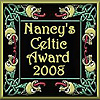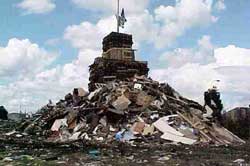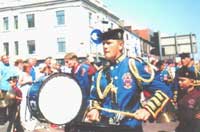| |

Traditions, folklore, history and more. If it's Irish, it's here. Or will be!
"People will not look forward to posterity who never look backward to their ancestors."
-Edmund Burke




Quotes
Library: Books, Movies, Music
Prints & Photos
Poetry
Jokes


Shops Ireland
Bunús na Gaeilge
(Basic Irish)
Circle of Prayer
Blessings
Did You Know?
Himself/Herself
Write to Us
Readers Write..
Links/Link to Us
Advertise with us
Awards & Testimonials
Submissions Guide


|
|
|
What the Twelfth means to me
by Stephen Moore
 I have fond memories of the Twelfth of July and for those first twelve days in July where everyone in the street and the community at large got excited for Ulster's National Holiday. For this is Ulster's Fourth of July, Ulster's Mardi Gras, potentially the biggest celebration and largest single tourist attraction Ulster and indeed Western Europe could have, if only the Northern Ireland Tourist Board, the British Government and the nationalist community would recognise it as such. I have fond memories of the Twelfth of July and for those first twelve days in July where everyone in the street and the community at large got excited for Ulster's National Holiday. For this is Ulster's Fourth of July, Ulster's Mardi Gras, potentially the biggest celebration and largest single tourist attraction Ulster and indeed Western Europe could have, if only the Northern Ireland Tourist Board, the British Government and the nationalist community would recognise it as such.
It is part of Ulster's, Ireland's, Britain's and Europe's shared heritage and history and the very legacy of the Battle of the Boyne has produced the Europe we have today. I now understand the importance of the Battle of the Boyne in providing civil and religious liberty for the people of Europe - then and now. I recognise how it was not only important for Ireland and Britain but for the freedom of Europe, and how it was the defining battle in a wider European power struggle. King William III's victory was a victory over Louis XIV and over France - and even Pope Alexander VIII of the day celebrated King William's victory over the expanding kingdom of Louis XIV. King William's victory provided the freedom and the opportunities for trade the people of Europe enjoy today.
As a young boy growing up in Carnmoney, I did not fully understand the historical importance of the celebrations but I realised it was important enough to celebrate. I discovered that it was the one chance during the year for the community and the people to be proud of their area, their country and who they were, and of course it was a period of excitement when people could enjoy the time with family and friends. Kids in the area co-operated together for a change as one team in obtaining as much wood and burning material as possible. There was so much pride in the street's bonfire and the commitment in protecting what can only be described as rubbish was immense.
Nowhere in the world would a crate or a tea chest be protected with such passion than in Ulster during July. There was a great status for the street if you obtained more crates than the other kids from surrounding areas. The competition was fierce and there was a bonfire on our street off the Ballyduff Road and another on the other side no more than thirty metres away. Both sets of kids decided in 1989 to forge an alliance for a mega tercentenary bonfire in 1990, to celebrate 300 years since the Battle of the Boyne. Unfortunately both sides could not agree on a suitable location as both sides requested for their traditional site to be used. Our side argued that our site was more elevated for those in the lower districts of Beverly and Mossley to see. A compromise site was not found and in 1990 nothing changed and the tradition of the two bonfires prevailed.
Sometimes our wood would go missing but would be swiftly located of course approximately 30 metres away and then retrieved. Our best wood was hidden in back yards, garages and surrounding fields to protect it from theft especially from the kids from the nearby Ballyduff Estate who always seemed bigger and harder than us. We would coax our parents to allow us to camp out on the tenth night as rumours of theft and sabotage were rife.
The only time that the team spirit would be threatened was on the eleventh day itself when the various opinions on the building process would come to the fore. Kids who did not show as much commitment in the run up to the big day were reminded of that fact. Fall-outs would occur and were usually sorted out on the football pitch in due course. Either way the bonfire was built, lit and enjoyed by all. I remember what we called the "Big Year" when our bonfire was so big that nearby houses had to soak their fences with water to prevent any damage. We were all so proud we even claimed that it was as big as Rathcoole and Tigers Bay even though it was a fraction the size. Taking into consideration the limited resources of a few young kids - our bonfire was just as good as any in Ulster.
One thing we enjoyed to the disgust of the adult spectators was the placing of aerosols deep in the cavities of the bonfire. They would explode to our delight as if harkening back to the very sounds of the Battle of the Boyne itself. We would be reprimanded but every year they continued to be a part of the bonfire celebrations in this little street in Carnmoney - boys will be boys!
After the bonfire had died down our parents would round us up for bed so we would get up early for breakfast and then the Twelfth celebrations themselves. Just when you thought it was all over - you had the parade and the days craic to look forward to. I remember feeling tired in the morning as I would have got up at regular intervals throughout the night to observe the bonfire and discover if it was still burning and if so - how much.
 How long it burned was very important when conversing with other kids as everyone measured the size and success of a bonfire by the simple observation of how long it burned - the longer it burned the better it was. The Twelfth parade itself was a fantastic array of colour, music, history and culture. I remember learning about the history of Ulster through what was graphically depicted on the banners carried in front of each individual lodge. People could learn about the 1641 Massacre of Protestants in Ulster, the glorious victory of King William at the Battle of the Boyne and in other areas, the landing of King William at Carrickfergus Castle and so on. Local history was also recreated through the pictures of local personalities, parish churches, local industries and so on. The time, the art, the colour, the enjoyment, the expense and sheer pride in what the parade represented was a fantastic sight for anyone, whether they be directly part of that particular culture or not. How long it burned was very important when conversing with other kids as everyone measured the size and success of a bonfire by the simple observation of how long it burned - the longer it burned the better it was. The Twelfth parade itself was a fantastic array of colour, music, history and culture. I remember learning about the history of Ulster through what was graphically depicted on the banners carried in front of each individual lodge. People could learn about the 1641 Massacre of Protestants in Ulster, the glorious victory of King William at the Battle of the Boyne and in other areas, the landing of King William at Carrickfergus Castle and so on. Local history was also recreated through the pictures of local personalities, parish churches, local industries and so on. The time, the art, the colour, the enjoyment, the expense and sheer pride in what the parade represented was a fantastic sight for anyone, whether they be directly part of that particular culture or not.
Then there was the field, the stalls, lunch and the time of rest and anticipation of what the return parade had in store for us, as it was always less orderly and full of laughs and fun. Bright orange wigs, even moustaches and glasses were to name but a few of the disguises that the participants might don on the way home. The Twelfth of July Battle of the Boyne celebrations are a wonderful sight to see, probably the most fantastic display of culture in Europe which can be enjoyed by anyone who decides to accommodate the culture and spectacle.
EDITORIAL NOTE: In times past, and especially in recent years, sectarian violence has marred the events commemorating the Battle of the Boyne and the victory of "King Willie." But, as the above article will attest, it wasn't always so. According to accounts we've read, there are stories of Catholic children helping their Protestant friends collect materials for the bonfires - and there is one particularly up-lifting account of a Catholic family who, while their children weren't allowed to participate in the parade, gave lemonade and crisps (potato chips) to Protestant youngsters involved with the preparations.
So, in recognition that this website must address the culture and customs of the entire island, we are pleased to have received permission to re-print this article and we encourage readers to visit the site where we found it: The Twelfth.
First Floor, 316 Shankill Road, Belfast BT13 3AB
To quote their philosophy: "The Twelfth aims to convey the spirit, colour and atmosphere of Europe's largest indigenous cultural festival. We have no connection with the Orange Order, but we do fully support the concept of civil and religious liberties for all. We oppose negative religious bigotry. We believe in heritage, not hate, and celebration, not provocation. We extend mutual cultural respect to all other peoples."
We couldn't agree more.
Few of those today who carry violence in their hearts over the religious schism in Northern Ireland, seem to consider the history of James and William.
James was welcomed on the throne in 1685 and men hoped he would be content to treat religion as a private affair. He was not to be so generous. He built a huge standing army; a mistake since it reminded many of the military oligarchy of Cromwell. He then forcibly imposed Catholics in all positions of power. The stage was set.
The battles in Ireland were nothing more than a rebellion of partisans of James II. The fact that the Pope celebrated the victory of William was a good indicator of the real issue. James was closely allied with Louis XIV of France. Had he won back his throne, the balance of power in Europe would have shifted dangerously. Thus, the superficially strange happiness of the Pope. He celebrated the overthrow of a Catholic King by a Protestant successor.
Even with all of this, William only lasted three years. His horse, Sorrell, stumbled on a molehill. William was thrown and broke his collarbone. He died a few days later.
|
|
Fri, Sep 27, 2024
 The Galway Hooker The Galway Hooker
This unique vessel, with its distinctive curved lines and bright red sails, originated in the village of Claddagh. During the 19th century, hookers supported a significant fishing industry and also carried goods, livestock and fuel. Seán Rainey is remembered for building the last of the original boats, the Truelight, for Martin Oliver who was to become the last king of the Claddagh; as king, he was entitled to white sails on his boat. Since the mid seventies, many of the old sailing craft which were on the verge of extinction have been lovingly restored and new ones have been built. During the summer months they can be seen at festivals such a Cruinniú na mBád - the Gathering of the Boats - in Kinvara.
Click for More Culture Corner.
If you ever wanted a great bedside trip around this "war-torn" wee patch of land, buy this book, take about three days off work and read it (with a bottle of Bush by your side). You will laugh, and you will cry, but you will have gotten one step closer to the nicest folk on earth. Peter from the proud village of Doagh.
Click here for Silver Linings.
|
Well-researched and wide-ranging, this is also a hugely-engaging and deeply moving book. It is clear Susan McKay has also taken considerable personal risks in gathering the material for this important, honest work that will remain an important historical record for generations to come.
Adapted from an amazon review.
Click here for Northern protestants.
While we normally shy away from politics, recent events have led us to an exploration of the complexities that surround the sectarian violence in Ulster. Our search turned up this excellent history of the conflict. Featuring a detailed chronology as well as a glossary and index, Making Sense Of The Troubles is highly recommended for the non-specialist general reader who seeks to better understand the politically charged and confrontational events in Northern Ireland.
Click here for making Sense.
|
|
|
|
|




 The Galway Hooker
The Galway Hooker